Unit 3 How do you get to school? 教案 2023-2024学年人教版七年级英语下册
文档属性
| 名称 | Unit 3 How do you get to school? 教案 2023-2024学年人教版七年级英语下册 | 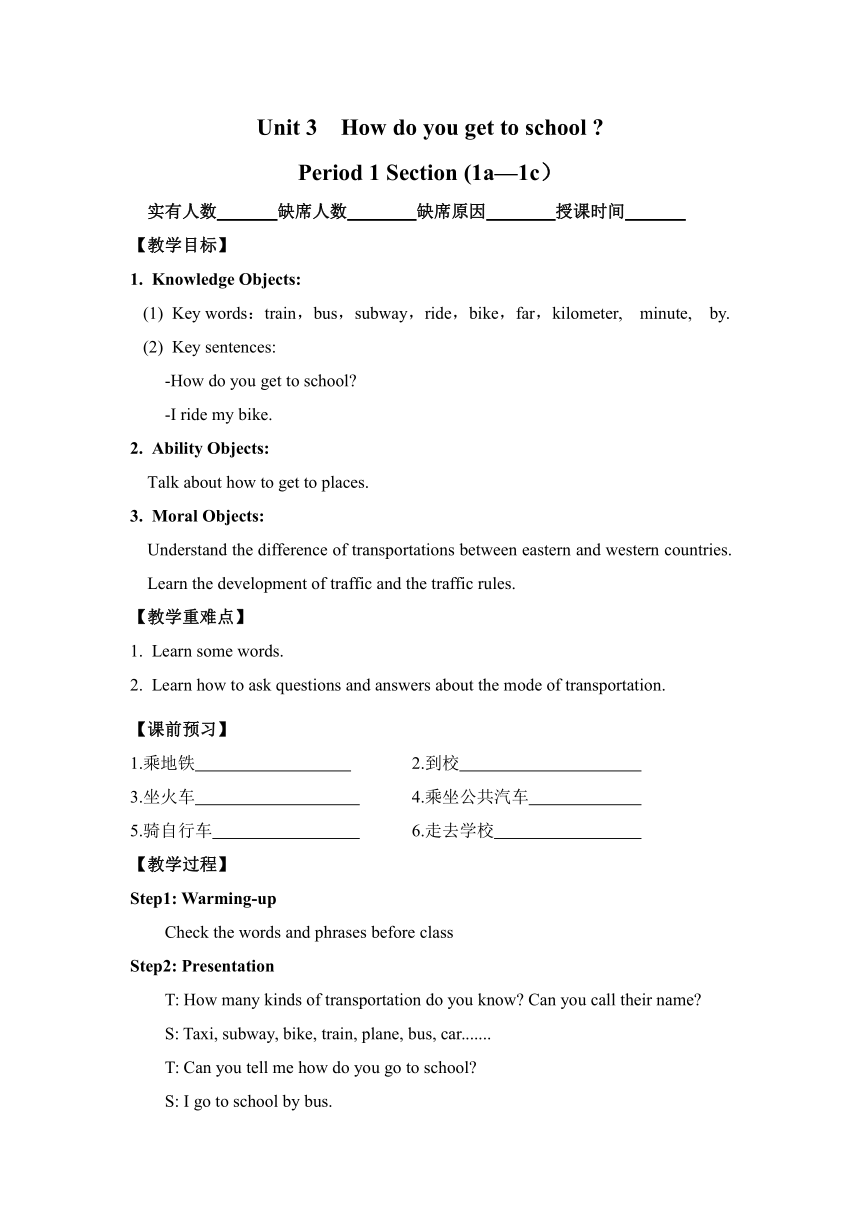 | |
| 格式 | docx | ||
| 文件大小 | 33.4KB | ||
| 资源类型 | 教案 | ||
| 版本资源 | 人教新目标(Go for it)版 | ||
| 科目 | 英语 | ||
| 更新时间 | 2024-06-17 16:22:34 | ||
图片预览

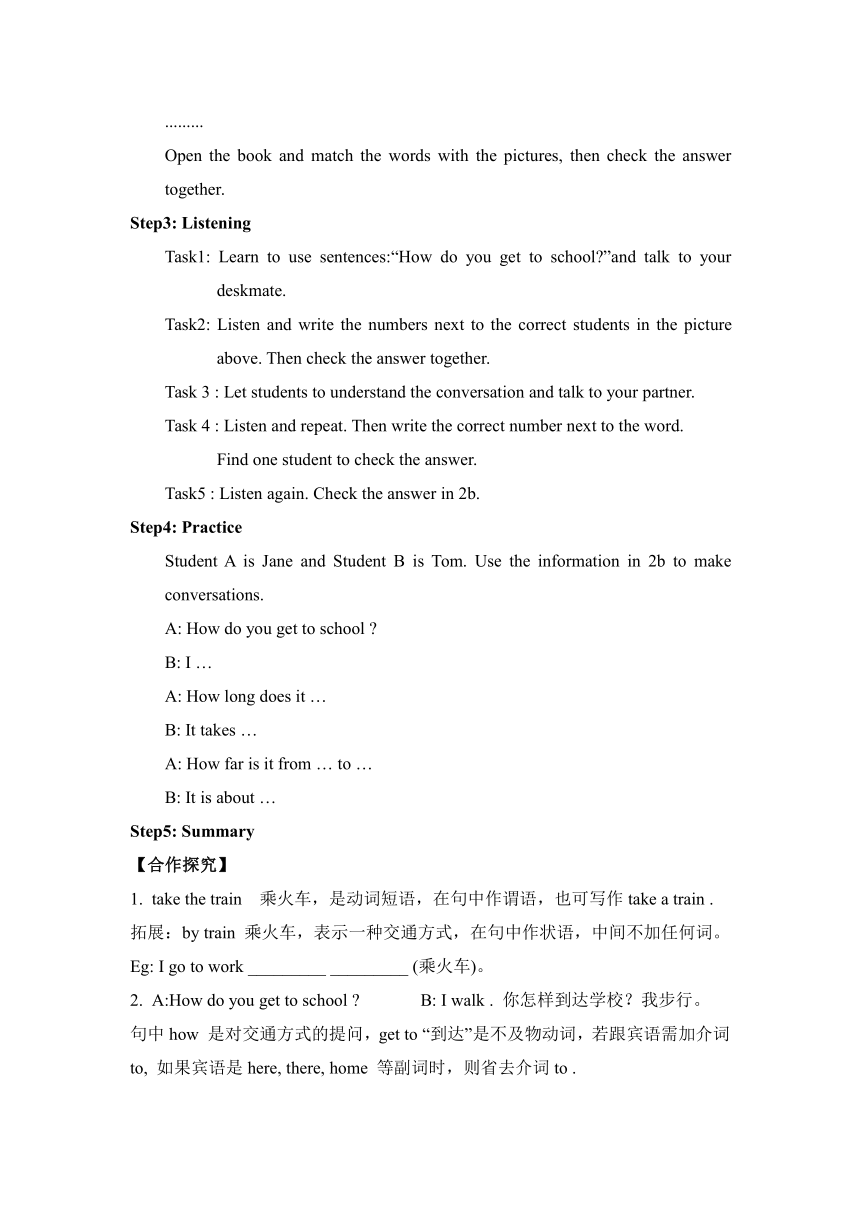
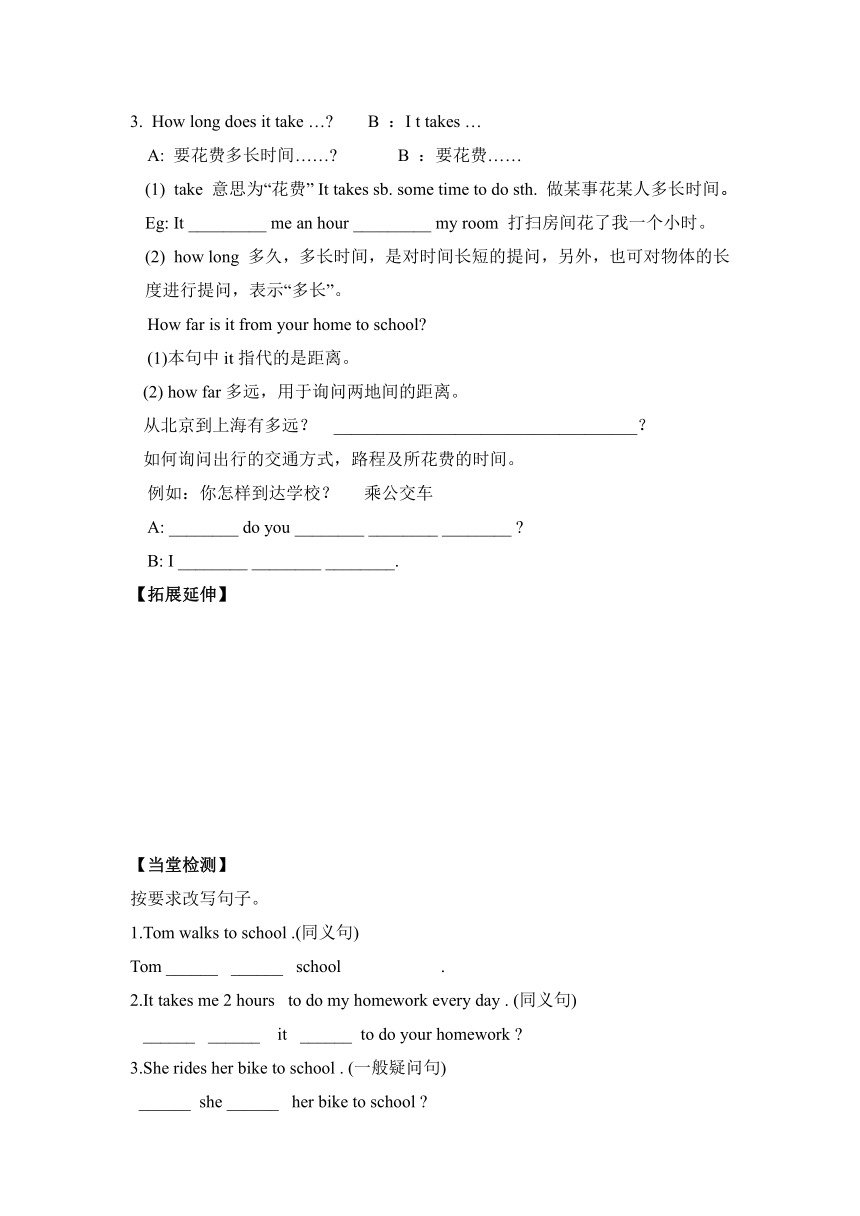
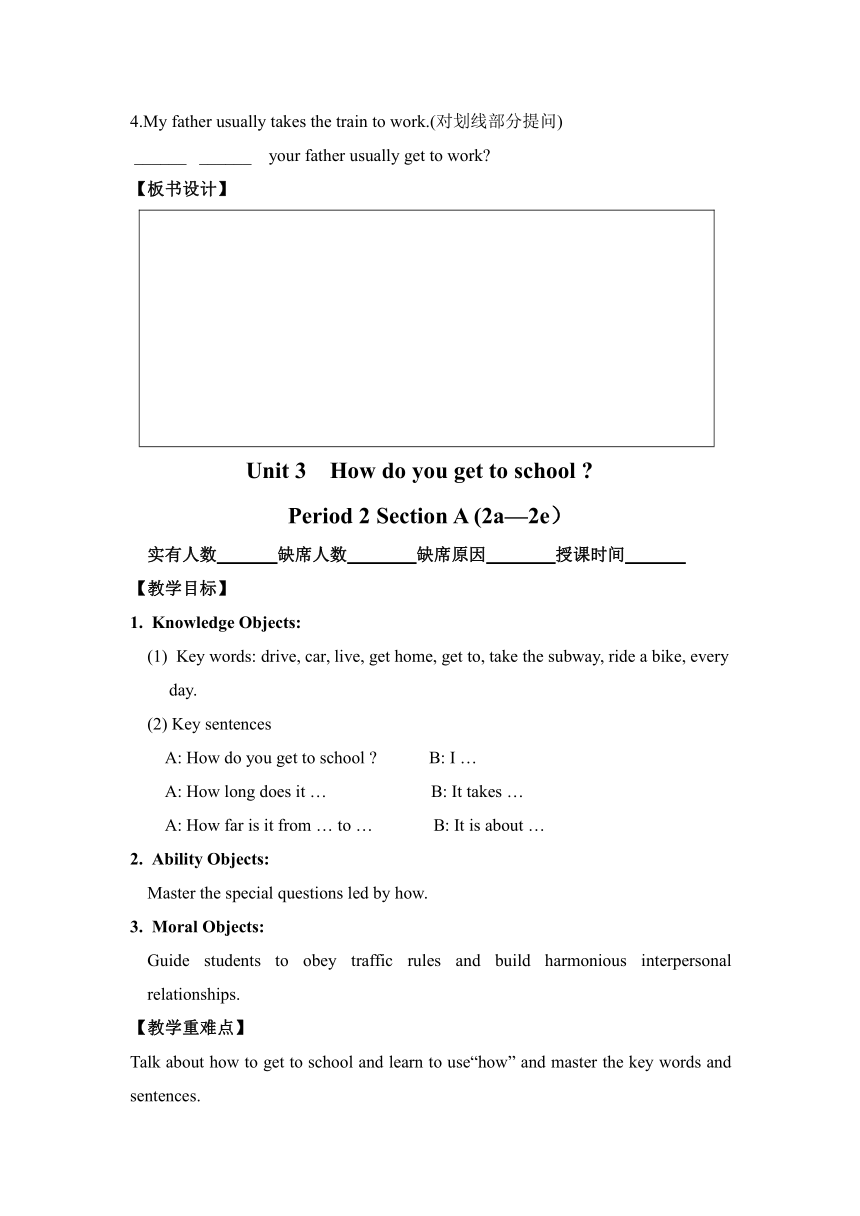
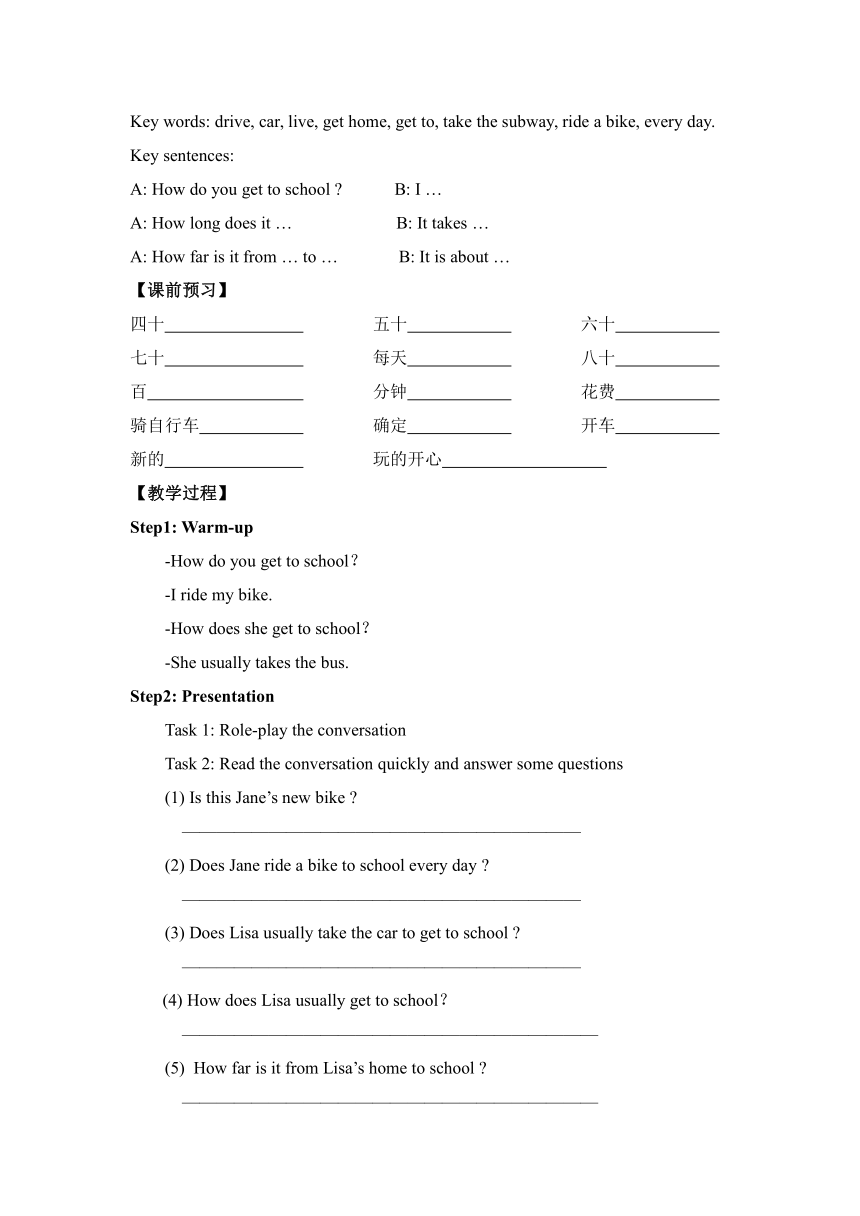
文档简介
Unit 3 How do you get to school
Period 1 Section (1a—1c)
实有人数 缺席人数 缺席原因 授课时间
【教学目标】
Knowledge Objects:
Key words:train,bus,subway,ride,bike,far,kilometer, minute, by.
Key sentences:
-How do you get to school
-I ride my bike.
Ability Objects:
Talk about how to get to places.
Moral Objects:
Understand the difference of transportations between eastern and western countries. Learn the development of traffic and the traffic rules.
【教学重难点】
Learn some words.
Learn how to ask questions and answers about the mode of transportation.
【课前预习】
1.乘地铁 2.到校
3.坐火车 4.乘坐公共汽车
5.骑自行车 6.走去学校
【教学过程】
Step1: Warming-up
Check the words and phrases before class
Step2: Presentation
T: How many kinds of transportation do you know Can you call their name
S: Taxi, subway, bike, train, plane, bus, car.......
T: Can you tell me how do you go to school
S: I go to school by bus.
.........
Open the book and match the words with the pictures, then check the answer together.
Step3: Listening
Task1: Learn to use sentences:“How do you get to school ”and talk to your deskmate.
Task2: Listen and write the numbers next to the correct students in the picture above. Then check the answer together.
Task 3 : Let students to understand the conversation and talk to your partner.
Task 4 : Listen and repeat. Then write the correct number next to the word.
Find one student to check the answer.
Task5 : Listen again. Check the answer in 2b.
Step4: Practice
Student A is Jane and Student B is Tom. Use the information in 2b to make conversations.
A: How do you get to school
B: I …
A: How long does it …
B: It takes …
A: How far is it from … to …
B: It is about …
Step5: Summary
【合作探究】
take the train 乘火车,是动词短语,在句中作谓语,也可写作take a train .
拓展:by train 乘火车,表示一种交通方式,在句中作状语,中间不加任何词。Eg: I go to work _________ _________ (乘火车)。
A:How do you get to school B: I walk . 你怎样到达学校?我步行。
句中how 是对交通方式的提问,get to “到达”是不及物动词,若跟宾语需加介词to, 如果宾语是here, there, home 等副词时,则省去介词to .
How long does it take … B :I t takes …
A: 要花费多长时间…… B :要花费……
take 意思为“花费” It takes sb. some time to do sth. 做某事花某人多长时间。Eg: It _________ me an hour _________ my room 打扫房间花了我一个小时。
how long 多久,多长时间,是对时间长短的提问,另外,也可对物体的长度进行提问,表示“多长”。
How far is it from your home to school
(1)本句中it指代的是距离。
(2) how far多远,用于询问两地间的距离。
从北京到上海有多远? ___________________________________?
如何询问出行的交通方式,路程及所花费的时间。
例如:你怎样到达学校? 乘公交车
A: ________ do you ________ ________ ________
B: I ________ ________ ________.
【拓展延伸】
【当堂检测】
按要求改写句子。
1.Tom walks to school .(同义句)
Tom ______ ______ school .
2.It takes me 2 hours to do my homework every day . (同义句)
______ ______ it ______ to do your homework
3.She rides her bike to school . (一般疑问句)
______ she ______ her bike to school
4.My father usually takes the train to work.(对划线部分提问)
______ ______ your father usually get to work
【板书设计】
Unit 3 How do you get to school
Period 2 Section A (2a—2e)
实有人数 缺席人数 缺席原因 授课时间
【教学目标】
Knowledge Objects:
Key words: drive, car, live, get home, get to, take the subway, ride a bike, every
day.
(2) Key sentences
A: How do you get to school B: I …
A: How long does it … B: It takes …
A: How far is it from … to … B: It is about …
Ability Objects:
Master the special questions led by how.
Moral Objects:
Guide students to obey traffic rules and build harmonious interpersonal relationships.
【教学重难点】
Talk about how to get to school and learn to use“how” and master the key words and sentences.
Key words: drive, car, live, get home, get to, take the subway, ride a bike, every day.
Key sentences:
A: How do you get to school B: I …
A: How long does it … B: It takes …
A: How far is it from … to … B: It is about …
【课前预习】
四十 五十 六十
七十 每天 八十
百 分钟 花费
骑自行车 确定 开车
新的 玩的开心
【教学过程】
Step1: Warm-up
-How do you get to school?
-I ride my bike.
-How does she get to school?
-She usually takes the bus.
Step2: Presentation
Task 1: Role-play the conversation
Task 2: Read the conversation quickly and answer some questions
(1) Is this Jane’s new bike
———————————————————————
(2) Does Jane ride a bike to school every day
———————————————————————
(3) Does Lisa usually take the car to get to school
———————————————————————
(4) How does Lisa usually get to school?
————————————————————————
How far is it from Lisa’s home to school
————————————————————————
How long does it take Jane to get to school
————————————————————————
Task3: Check the answer together
Step3: Practice
Finish 3a and 3b, then check the answer
Ask your classmates questions and read their names in the chart. The first student to fill in all the blanks wins.
-How far is it from your home to school
-It’s about five kilometers.
Step4: Summary
【合作探究】
I ride it to school every day . every day:每天
ride 及物动词,意为“骑”后面可接bike ,horse ,motorbike等。
Eg: He rides a bike to school = He goes to school by bike .
every 之后用名词单数。
Eg: Every student has a dictionary .
A:Have a good day . B: You ,too.
A:祝你玩得开心。B: 你也一样。
当祝福对方的内容不是对方特有的情况下,都可以用You ,too. 来回答。但当祝福某人生日快乐时 ,只能用Thanks 来回答。
Eg: -----Happy New Year ----- You ,too. (The same to you )
-----Happy birthday。 -----Thanks .
Does Jane walk to school 简步行去上学吗?
此句中 walk to school 相当于go to school on foot .
Eg: She walks to school .
=She _______ _______ ______ _____ _______.
【拓展延伸】
【当堂检测】
按要求填写句子
1.你通常怎样去工作?我通常骑车去工作.
— _____ ______ you usually go to work
—I usually go to work _____ _____ ______.
2.你经常坐火车去天津吗?
Do you usually to Tianjin
3.你会骑自行车吗?
Can you
4. What do you think of Zhengzhou city (同义句)
________________________________________
5.Tom often goes to school by bus.(同义句)
Tom often______ ________ _______ to school.
【板书设计】
Unit 3 How do you get to school
Period 3 Section B (1a-1e )
实有人数 缺席人数 缺席原因 授课时间
【教学目标】
Knowledge Objects:
Key words:stop,bus stop,train station,subway station,think of
Key sentences:
-Does Jane walk to school
-No, she doesn't. She goes by bike.
-Do they take the bus to school
-No, they don’t. They walk.
Ability Objects
Can learn to express how to use the mode of transportation to get somewhere
Moral Object:
Get to know the different ways of traveling in eastern and western countries, and different traffic rules. Teach students to pay attention to traffic safety and deepen their understanding of traffic knowledge.
【教学重难点】
Learn some words and sentences.
Introduce your own and other people’s modes of transportation
【课前预习】
公交站点 火车站 公交车站
骑自行车 走路 多远
他祖父母家 认为 到学校
乘公交车 坐火车 乘坐地铁
【教学过程】
Step1: Revision and Lead-in
Review some new words and ask some questions
T:How do you get to school
S:I ride my bike.
T:How does she get to school
S:She usually takes the bus.
T:How long does it take to get to school
S:It’s takes about 15 minutes.
T:How far is it from your home to school
S:It’s only about two kilometers.
Step2: Presentation
Task1: Match the words with the pictures.
Task2: Tell your partner how you get to school. Imagine you use two types of transportation.
-How do you get to school
-Well, I ride my bike to the subway station. Then I take the subway.
Task3: Group A and Group B practice the sentences.
Step3: Listening
Task1:Listen and check the things that Mary wants to know.
Check the answer together
Task2:Listen again. How does Bob get to his grandparents’ home
Check 1 or 2.
Step4: Pair-work
-How does Bob get to his grandparents’ home
-He…
Step5: Summary
【合作探究】
bus stop 公共汽车站 此处stop作名词 意为 “车站、站点”
at the bus stop在公共汽车站台
区分: bus stop bus station公共汽车站
bus stop指城镇内外的停车点 bus station指能停、转车辆的汽车站点
拓展:stop 做动词 停止
stop to do sth 停下来去做某事 Let’s stop to have a rest.
stop doing sth停止做某事 Stop talking ,please.
Mary wants to know what he thinks of the trip.
玛丽想知道他觉得旅程怎么样。
“thinks of”意为“认为考虑”。 Of为介词,其后可接名词、代词或动名词做宾语。“表示…怎么样”时,可与think about互换。
注意 What do you think of … 意为“How do you like…
What do you think of this movie = How do you like this movie
【拓展延伸】
【当堂检测】
用所给词的适当形式填空。
Helen always ______ (get) to school at seven forty.
2. It’s about five ___________(kilometer) from Susan’s home to school.
3. Look! Here are two ________(bus).
4. How long does it take you ________ (do) your homework
5.The bus ride usually ________(take) about half an hour.
【板书设计】
Unit 3 How do you get to school
Period 4 Section B (2a-2d)
实有人数 缺席人数 缺席原因 授课时间
【学习目标】
Knowledge Object:
Key words and key sentence: cross, river, many, village, between, bridge, boat, year, afraid, like, villager, leave, dream, true,between…and…,be like, come true, be afraid
Key Sentences:
1. There is a very big river between their school and the village.
2. He’s like a father to me.
3. Can their dream come true
2. Ability Objects:
Through various reading exercises, students can learn some words and sentences, complete the reading comprehensive tasks and obtain relevant useful information.
3.Moral Objects:
Understand the transportation difficulties for children in poor areas to go to school. Children in cities should cherish their own living and learning conditions and motivate themselves to study hard.
【教学重难点】
Cultivate students reading strategies, let them be able to predict the information, obtain the specific information and process the information.
【课前预习】
一条很大的河 对于许多学生来说
在……和……之间 一个11岁的男孩
不得不 实现
和……玩 乘坐索道
【教学过程】
Step1: Lead-in
Show some map pictures of how people go to different places.
T: How do they get there
Ss: They get there ......
Step2: Presentation
Task1: Read the passage and circle the transportation about 2b
Task2: Read the passage about again and answer the question, and check the answer.
1 . How do the students in the village go to school
2 . Why do they go to school like this
3 . Does the boy like his school Why
4.What is the villagers' dream Do you think their dream can come true
Why or why not
Task3:Read the passage again. Complete the sentences with words from the passage. Then check the answer together.
Step3: Pair-work
Ask the students to work in groups of four and try to retell the passage according
to the key words on the screen one by one. Then retell the whole passage in their
own words.
Step4: Summary
【合作探究】
crossing the River to School.
cross 做动词,穿过;越过,指表面上的“穿过”主要指“横穿”
Don’t the road when the traffic light is red .
辨析:cross, across与 crossing
cross 动词 谓语 .Let’s cross the road now.
across 介词 做状语 They just live across the road.
crossing 名词 作主语、宾语 Turn left at the first crossing.
He is not afraid.
afraid 形容词,害怕的;畏惧的,是个表语形容词,其用法为
① be afraid of sth 害怕某事或某物 Most of the girls are afraid of dogs.
② be afraid to do sth 害怕做某事 My sister is afraid to stay at home alone.
③ be afraid +(that+) I’m afraid (that ) he can’t come.
【拓展延伸】
【当堂检测】
用所给词的适当形式填空
(
think of, be like, come true, drive to, get to
)
1.—How do you _________ school —By bike.
2. Mike _________work every morning because he has a new car.
3. He _________ his mother. They like helping others(别人).
4. My wish(愿望)will _________.
5. What do you _________ our school
【板书设计】
Unit 3 How do you get to school
Period 5 Section B (3c-self check)
实有人数 缺席人数 缺席原因 授课时间
【教学目标】
Knowledge Objects:
Master the key words and sentences and the use of how.
Ability Objects:
Learn to write an article about how to get to places.
Moral Objects:
Learn to write the article of unit3, and know about traffic rules.
【教学重难点】
Learn to write an article about transportation.
【写作要求】
开篇介绍人员
具体介绍某人使用的交通方式
表达自己的看法
【写作素材】
词汇:
way方式; walk步行; drive 开车; take 费; go to work 上班; walk to school 步行上学; drive one's car 开某人的车; take the subway 乘地铁; by bike 骑自行车; ways of.... ...的方式
句型:
He/ She goes to .by..他/她乘…去…
2 . He /She takes the /a to .. 他/她乘…去…
3.It takes sb. some time to do sth .某人花多少时间做某事。
4.lt' s about…miles /kilometers from…to… 从…到…大约有…英里/公里。
5.Sb. lives far from /near… 某人住得离……远/某人住在…附近。
【写作模板】
【教学反思】
Period 1 Section (1a—1c)
实有人数 缺席人数 缺席原因 授课时间
【教学目标】
Knowledge Objects:
Key words:train,bus,subway,ride,bike,far,kilometer, minute, by.
Key sentences:
-How do you get to school
-I ride my bike.
Ability Objects:
Talk about how to get to places.
Moral Objects:
Understand the difference of transportations between eastern and western countries. Learn the development of traffic and the traffic rules.
【教学重难点】
Learn some words.
Learn how to ask questions and answers about the mode of transportation.
【课前预习】
1.乘地铁 2.到校
3.坐火车 4.乘坐公共汽车
5.骑自行车 6.走去学校
【教学过程】
Step1: Warming-up
Check the words and phrases before class
Step2: Presentation
T: How many kinds of transportation do you know Can you call their name
S: Taxi, subway, bike, train, plane, bus, car.......
T: Can you tell me how do you go to school
S: I go to school by bus.
.........
Open the book and match the words with the pictures, then check the answer together.
Step3: Listening
Task1: Learn to use sentences:“How do you get to school ”and talk to your deskmate.
Task2: Listen and write the numbers next to the correct students in the picture above. Then check the answer together.
Task 3 : Let students to understand the conversation and talk to your partner.
Task 4 : Listen and repeat. Then write the correct number next to the word.
Find one student to check the answer.
Task5 : Listen again. Check the answer in 2b.
Step4: Practice
Student A is Jane and Student B is Tom. Use the information in 2b to make conversations.
A: How do you get to school
B: I …
A: How long does it …
B: It takes …
A: How far is it from … to …
B: It is about …
Step5: Summary
【合作探究】
take the train 乘火车,是动词短语,在句中作谓语,也可写作take a train .
拓展:by train 乘火车,表示一种交通方式,在句中作状语,中间不加任何词。Eg: I go to work _________ _________ (乘火车)。
A:How do you get to school B: I walk . 你怎样到达学校?我步行。
句中how 是对交通方式的提问,get to “到达”是不及物动词,若跟宾语需加介词to, 如果宾语是here, there, home 等副词时,则省去介词to .
How long does it take … B :I t takes …
A: 要花费多长时间…… B :要花费……
take 意思为“花费” It takes sb. some time to do sth. 做某事花某人多长时间。Eg: It _________ me an hour _________ my room 打扫房间花了我一个小时。
how long 多久,多长时间,是对时间长短的提问,另外,也可对物体的长度进行提问,表示“多长”。
How far is it from your home to school
(1)本句中it指代的是距离。
(2) how far多远,用于询问两地间的距离。
从北京到上海有多远? ___________________________________?
如何询问出行的交通方式,路程及所花费的时间。
例如:你怎样到达学校? 乘公交车
A: ________ do you ________ ________ ________
B: I ________ ________ ________.
【拓展延伸】
【当堂检测】
按要求改写句子。
1.Tom walks to school .(同义句)
Tom ______ ______ school .
2.It takes me 2 hours to do my homework every day . (同义句)
______ ______ it ______ to do your homework
3.She rides her bike to school . (一般疑问句)
______ she ______ her bike to school
4.My father usually takes the train to work.(对划线部分提问)
______ ______ your father usually get to work
【板书设计】
Unit 3 How do you get to school
Period 2 Section A (2a—2e)
实有人数 缺席人数 缺席原因 授课时间
【教学目标】
Knowledge Objects:
Key words: drive, car, live, get home, get to, take the subway, ride a bike, every
day.
(2) Key sentences
A: How do you get to school B: I …
A: How long does it … B: It takes …
A: How far is it from … to … B: It is about …
Ability Objects:
Master the special questions led by how.
Moral Objects:
Guide students to obey traffic rules and build harmonious interpersonal relationships.
【教学重难点】
Talk about how to get to school and learn to use“how” and master the key words and sentences.
Key words: drive, car, live, get home, get to, take the subway, ride a bike, every day.
Key sentences:
A: How do you get to school B: I …
A: How long does it … B: It takes …
A: How far is it from … to … B: It is about …
【课前预习】
四十 五十 六十
七十 每天 八十
百 分钟 花费
骑自行车 确定 开车
新的 玩的开心
【教学过程】
Step1: Warm-up
-How do you get to school?
-I ride my bike.
-How does she get to school?
-She usually takes the bus.
Step2: Presentation
Task 1: Role-play the conversation
Task 2: Read the conversation quickly and answer some questions
(1) Is this Jane’s new bike
———————————————————————
(2) Does Jane ride a bike to school every day
———————————————————————
(3) Does Lisa usually take the car to get to school
———————————————————————
(4) How does Lisa usually get to school?
————————————————————————
How far is it from Lisa’s home to school
————————————————————————
How long does it take Jane to get to school
————————————————————————
Task3: Check the answer together
Step3: Practice
Finish 3a and 3b, then check the answer
Ask your classmates questions and read their names in the chart. The first student to fill in all the blanks wins.
-How far is it from your home to school
-It’s about five kilometers.
Step4: Summary
【合作探究】
I ride it to school every day . every day:每天
ride 及物动词,意为“骑”后面可接bike ,horse ,motorbike等。
Eg: He rides a bike to school = He goes to school by bike .
every 之后用名词单数。
Eg: Every student has a dictionary .
A:Have a good day . B: You ,too.
A:祝你玩得开心。B: 你也一样。
当祝福对方的内容不是对方特有的情况下,都可以用You ,too. 来回答。但当祝福某人生日快乐时 ,只能用Thanks 来回答。
Eg: -----Happy New Year ----- You ,too. (The same to you )
-----Happy birthday。 -----Thanks .
Does Jane walk to school 简步行去上学吗?
此句中 walk to school 相当于go to school on foot .
Eg: She walks to school .
=She _______ _______ ______ _____ _______.
【拓展延伸】
【当堂检测】
按要求填写句子
1.你通常怎样去工作?我通常骑车去工作.
— _____ ______ you usually go to work
—I usually go to work _____ _____ ______.
2.你经常坐火车去天津吗?
Do you usually to Tianjin
3.你会骑自行车吗?
Can you
4. What do you think of Zhengzhou city (同义句)
________________________________________
5.Tom often goes to school by bus.(同义句)
Tom often______ ________ _______ to school.
【板书设计】
Unit 3 How do you get to school
Period 3 Section B (1a-1e )
实有人数 缺席人数 缺席原因 授课时间
【教学目标】
Knowledge Objects:
Key words:stop,bus stop,train station,subway station,think of
Key sentences:
-Does Jane walk to school
-No, she doesn't. She goes by bike.
-Do they take the bus to school
-No, they don’t. They walk.
Ability Objects
Can learn to express how to use the mode of transportation to get somewhere
Moral Object:
Get to know the different ways of traveling in eastern and western countries, and different traffic rules. Teach students to pay attention to traffic safety and deepen their understanding of traffic knowledge.
【教学重难点】
Learn some words and sentences.
Introduce your own and other people’s modes of transportation
【课前预习】
公交站点 火车站 公交车站
骑自行车 走路 多远
他祖父母家 认为 到学校
乘公交车 坐火车 乘坐地铁
【教学过程】
Step1: Revision and Lead-in
Review some new words and ask some questions
T:How do you get to school
S:I ride my bike.
T:How does she get to school
S:She usually takes the bus.
T:How long does it take to get to school
S:It’s takes about 15 minutes.
T:How far is it from your home to school
S:It’s only about two kilometers.
Step2: Presentation
Task1: Match the words with the pictures.
Task2: Tell your partner how you get to school. Imagine you use two types of transportation.
-How do you get to school
-Well, I ride my bike to the subway station. Then I take the subway.
Task3: Group A and Group B practice the sentences.
Step3: Listening
Task1:Listen and check the things that Mary wants to know.
Check the answer together
Task2:Listen again. How does Bob get to his grandparents’ home
Check 1 or 2.
Step4: Pair-work
-How does Bob get to his grandparents’ home
-He…
Step5: Summary
【合作探究】
bus stop 公共汽车站 此处stop作名词 意为 “车站、站点”
at the bus stop在公共汽车站台
区分: bus stop bus station公共汽车站
bus stop指城镇内外的停车点 bus station指能停、转车辆的汽车站点
拓展:stop 做动词 停止
stop to do sth 停下来去做某事 Let’s stop to have a rest.
stop doing sth停止做某事 Stop talking ,please.
Mary wants to know what he thinks of the trip.
玛丽想知道他觉得旅程怎么样。
“thinks of”意为“认为考虑”。 Of为介词,其后可接名词、代词或动名词做宾语。“表示…怎么样”时,可与think about互换。
注意 What do you think of … 意为“How do you like…
What do you think of this movie = How do you like this movie
【拓展延伸】
【当堂检测】
用所给词的适当形式填空。
Helen always ______ (get) to school at seven forty.
2. It’s about five ___________(kilometer) from Susan’s home to school.
3. Look! Here are two ________(bus).
4. How long does it take you ________ (do) your homework
5.The bus ride usually ________(take) about half an hour.
【板书设计】
Unit 3 How do you get to school
Period 4 Section B (2a-2d)
实有人数 缺席人数 缺席原因 授课时间
【学习目标】
Knowledge Object:
Key words and key sentence: cross, river, many, village, between, bridge, boat, year, afraid, like, villager, leave, dream, true,between…and…,be like, come true, be afraid
Key Sentences:
1. There is a very big river between their school and the village.
2. He’s like a father to me.
3. Can their dream come true
2. Ability Objects:
Through various reading exercises, students can learn some words and sentences, complete the reading comprehensive tasks and obtain relevant useful information.
3.Moral Objects:
Understand the transportation difficulties for children in poor areas to go to school. Children in cities should cherish their own living and learning conditions and motivate themselves to study hard.
【教学重难点】
Cultivate students reading strategies, let them be able to predict the information, obtain the specific information and process the information.
【课前预习】
一条很大的河 对于许多学生来说
在……和……之间 一个11岁的男孩
不得不 实现
和……玩 乘坐索道
【教学过程】
Step1: Lead-in
Show some map pictures of how people go to different places.
T: How do they get there
Ss: They get there ......
Step2: Presentation
Task1: Read the passage and circle the transportation about 2b
Task2: Read the passage about again and answer the question, and check the answer.
1 . How do the students in the village go to school
2 . Why do they go to school like this
3 . Does the boy like his school Why
4.What is the villagers' dream Do you think their dream can come true
Why or why not
Task3:Read the passage again. Complete the sentences with words from the passage. Then check the answer together.
Step3: Pair-work
Ask the students to work in groups of four and try to retell the passage according
to the key words on the screen one by one. Then retell the whole passage in their
own words.
Step4: Summary
【合作探究】
crossing the River to School.
cross 做动词,穿过;越过,指表面上的“穿过”主要指“横穿”
Don’t the road when the traffic light is red .
辨析:cross, across与 crossing
cross 动词 谓语 .Let’s cross the road now.
across 介词 做状语 They just live across the road.
crossing 名词 作主语、宾语 Turn left at the first crossing.
He is not afraid.
afraid 形容词,害怕的;畏惧的,是个表语形容词,其用法为
① be afraid of sth 害怕某事或某物 Most of the girls are afraid of dogs.
② be afraid to do sth 害怕做某事 My sister is afraid to stay at home alone.
③ be afraid +(that+) I’m afraid (that ) he can’t come.
【拓展延伸】
【当堂检测】
用所给词的适当形式填空
(
think of, be like, come true, drive to, get to
)
1.—How do you _________ school —By bike.
2. Mike _________work every morning because he has a new car.
3. He _________ his mother. They like helping others(别人).
4. My wish(愿望)will _________.
5. What do you _________ our school
【板书设计】
Unit 3 How do you get to school
Period 5 Section B (3c-self check)
实有人数 缺席人数 缺席原因 授课时间
【教学目标】
Knowledge Objects:
Master the key words and sentences and the use of how.
Ability Objects:
Learn to write an article about how to get to places.
Moral Objects:
Learn to write the article of unit3, and know about traffic rules.
【教学重难点】
Learn to write an article about transportation.
【写作要求】
开篇介绍人员
具体介绍某人使用的交通方式
表达自己的看法
【写作素材】
词汇:
way方式; walk步行; drive 开车; take 费; go to work 上班; walk to school 步行上学; drive one's car 开某人的车; take the subway 乘地铁; by bike 骑自行车; ways of.... ...的方式
句型:
He/ She goes to .by..他/她乘…去…
2 . He /She takes the /a to .. 他/她乘…去…
3.It takes sb. some time to do sth .某人花多少时间做某事。
4.lt' s about…miles /kilometers from…to… 从…到…大约有…英里/公里。
5.Sb. lives far from /near… 某人住得离……远/某人住在…附近。
【写作模板】
【教学反思】
同课章节目录
- Unit 1 Can you play the guitar?
- Section A
- Section B
- Unit 2 What time do you go to school?
- Section A
- Section B
- Unit 3 How do you get to school?
- Section A
- Section B
- Unit 4 Don't eat in class.
- Section A
- Section B
- Unit 5 Why do you like pandas?
- Section A
- Section B
- Unit 6 I'm watching TV.
- Section A
- Section B
- Review of Units 1-6
- Unit 7 It's raining!
- Section A
- Section B
- Unit 8 Is there a post office near here?
- Section A
- Section B
- Unit 9 What does he look like?
- Section A
- Section B
- Unit 10 I'd like some noodles.
- Section A
- Section B
- Unit 11 How was your school trip?
- Section A
- Section B
- Unit 12 What did you do last weekend?
- Section A
- Section B
